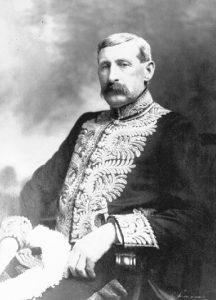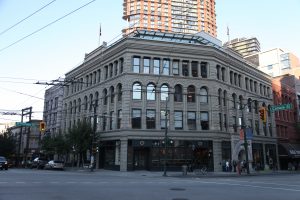By Michael Souza
The Bank of Vancouver was a short-lived Canadian chartered bank established in Vancouver, B.C., on July 30, 1910, before going out of business about four and a half years later on Dec. 14, 1914.
The Bank of Vancouver was one of three B.C. banks that sprang up in the late 19th and early 20th centuries.
The others were the Macdonald and Company Bank (1858-64), which went out of business after a robbery, and the first Bank of British Columbia (1862-1901), which was taken over by the Bank of Commerce.
In 1907, prominent B.C. businessman Robert Purves McLennan felt Canada’s central banks were inadequately supporting the province’s industry and commerce. He, along with other businessmen, promoted the Chartered Bank of British Columbia.
Its founders included Lieutenant Governor Thomas Paterson and William Harold Malkin, a major food wholesaler who later became the mayor of Vancouver in 1929. In 1934, Malkin built the Marion Malkin Memorial Bowl (also known as the Malkin Bowl) in Stanley Park.
On April 3, 1908, they incorporated the Bank of Vancouver with a capital stock of $2 million, of which $1.169 million was subscribed and $830,000 paid up. The “Flack Block” on the corner of Hastings Street and Cambie Street would become the bank’s future head office.

Thomas Wilson Paterson (shown) and William Harold Malkin incorporated the Bank of Vancouver on April 3, 1908.
OPENED IN 1910
The Bank of Vancouver opened in the Flack Block on July 30, 1910, with McLennan as president.
Although financially very strong, the directors lacked banking experience.
In 1910, Prime Minister Wilfrid Laurier officially opened the Industrial Exhibition in Vancouver. In time, this event became the Pacific National Exhibition – or the PNE.
To promote savings, the bank issued steel banks to customers. The bank kept the key and would open the lock when the customer took his savings to the bank in the hopes the accumulated savings would be deposited with the bank.
At its height, the Bank of Vancouver had a dozen branches scattered around the province with four in Vancouver, two in Victoria and one each in South Vancouver, Coquitlam, New Westminster, Chilliwack, Fort Fraser and Fort George (now called Prince George). It issued $5, $10, $20, $50 and $100 banknotes.
Even before 1909, British Columbia was facing a fantastic boom. Logging firms were looking ahead to good markets, the future of the mining industry was looking rosy and railroads were being planned and built. Vancouver and Victoria were growing rapidly.
When the bank opened in 1910, British Columbia was in the midst of this industrial and real estate boom with investment money coming in from the United States, Britain and Germany. Real-estate prices were doubling and redoubling quickly, and speculation was rampant. The construction industry was working at high capacity.
A SHIFTING ECONOMY & WORLD WAR

The bank’s former location, the ‘Flack Block’ at 163 West Hastings St., recently underwent a $20 million renovation.
But difficult economic conditions started in the autumn of 1912 alongside a lengthy coal strike on Vancouver Island that remained unsettled until 1914.
In 1913, with rumours of an impending war, both British and German capital began leaving British Columbia. Investments dried up, real-estate speculation ceased and construction halted.
A short article in The Toronto World newspaper on Jan. 15, 1914, discussed the possibility of the Bank of Vancouver being absorbed by another financial institution. It was a harbinger of the problems faced by the bank.
From 1912, the bank struggled along for two more years. It had expanded too quickly and carried some problematic loans. The Chilliwack branch closed in 1912, and the Broadway Branch in Vancouver closed in April 1913 after operating at a serious loss.
The failure of the Dominion Trust Company in October 1914 was a crushing blow that shook public confidence in financial institutions. Depositors began withdrawing their money from the Bank of Vancouver and deposits shrank from a total of $1.5 million in November 1913 to $395,000 on Dec. 22, 1914.
On Dec. 14, 1914, the bank was forced to suspend payments and close its doors.
An article from The Journal of Commerce on Dec. 15, 1914, outlines the plight of the Bank of Vancouver.
According to various newspaper articles, the debts of the bank were still being settled in 1917. Another article from the Quebec Telegraph on Jan. 19 outlined the Supreme Court ruling that the $282,295 still owed by share subscribers must be paid.
The affairs of the bank were finally wound up in 1935.
FEW NOTES AVAILABLE ON MARKET
When the bank went under, there was reportedly $325,000 in Bank of Vancouver notes in circulation.
Most of those notes were probably redeemed by other banks and then destroyed.
According to B.C.-based banknote collector Ron Greene, there are only nine known Bank of Vancouver circulating banknotes, including six $5 notes, a pair of $10 notes and one $20 note. No $50 or $100 notes seem to have survived aside from proofs; however, Greene added $3,200 in Bank of Vancouver money is still outstanding, so it’s possible there are other notes in collections no one knows about – yet.
At the official auction held in conjunction with the 2008 convention of the Canadian Numismatic Association (now the Royal Canadian Numismatic Association), auctioneer Marc Verret sold a Bank of Vancouver $5 note for $28,750.
On June 24, 2010, the first $5 banknote printed by the Bank of Vancouver – serial number “000001” – crossed the auction block for $177,000.
In November 2019, I successfully bid on a Bank of Vancouver cancelled cheque offered for sale on eBay. It was drawn on the bank on Nov. 5, 1914, and a month later, the bank closed its doors.
Later that same month, Brian Grant Duff, of All Nations Stamp & Coin in Vancouver, offered a pair of vignettes used on the Bank of Vancouver’s $5 and $10 banknotes in his weekly auction. The pair of notes sold for $154.
After the failure of the bank, McLennan went into politics as a Liberal for the riding of Vancouver-Burrard but was defeated in 1925. He died in Vancouver on July 27, 1927, at age 66. He’s buried at Mountain View Cemetery.
The bank’s former location has recently undergone a $20 million renovation, but the façade remains the same.

